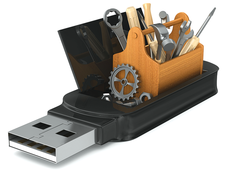Creating multiboot-capable USB sticks
Many Boots

A USB stick holding all the distributions you need can be a useful mobile toolbox. This month we explore three tools for creating multiboot-capable memory sticks.
Live boot has been part of the Linux scene for many years. The idea behind live boot is simple but very powerful: Carry the operating system with you wherever you go, and when you need it, plug it in and boot to it. Live systems let you test out an operating system before you install, which is why several common Linux distros offer pre-built live DVD images. Perhaps the most famous use for Live systems is troubleshooting. If a hard drive failure or a corrupt configuration file prevents the installed system from booting, you can boot to a live disc and start searching for the source of the trouble. Distros such as Knoppix and SystemRescueCd became famous as tools for system administrators to carry with them when called to rescue failed computers.
Old-school live systems traveled around on a CD or DVD – typically read-only media, which was a limitation on their suitability for everyday use. In the age of USB sticks, live systems have become more flexible. Support for persistence means you can customize the system in ways that were not possible with the older generation. USB sticks have also eliminated the strict size limitations that affect CDs and DVDs. USB sticks come in an assortment of sizes, and some are bigger than hard drives were in the not-so-distant past.
The large size and flexibility of USB sticks has led to another important innovation in live Linux. The first USB-based live systems were modeled on the previous CD/DVD model. You burned a system image to the stick, then started the system with the disc in place to boot the image. The best of the new live boot tools take the technology to another level. These tools basically load a boot manager onto the USB stick, then let you copy multiple system images onto the disc. You can therefore boot multiple operating systems from the same USB stick.
[...]
Buy this article as PDF
(incl. VAT)
Buy Linux Magazine
Subscribe to our Linux Newsletters
Find Linux and Open Source Jobs
Subscribe to our ADMIN Newsletters
Support Our Work
Linux Magazine content is made possible with support from readers like you. Please consider contributing when you’ve found an article to be beneficial.

News
-
Asahi Linux Runs into Issues with M4 Support
Due to Apple Silicon changes, the Asahi Linux project is at odds with adding support for the M4 chips.
-
Plasma 6.3.4 Now Available
Although not a major release, Plasma 6.3.4 does fix some bugs and offer a subtle change for the Plasma sidebar.
-
Linux Kernel 6.15 First Release Candidate Now Available
Linux Torvalds has announced that the release candidate for the final release of the Linux 6.15 series is now available.
-
Akamai Will Host kernel.org
The organization dedicated to cloud-based solutions has agreed to host kernel.org to deliver long-term stability for the development team.
-
Linux Kernel 6.14 Released
The latest Linux kernel has arrived with extra Rust support and more.
-
EndeavorOS Mercury Neo Available
A new release from the EndeavorOS team ships with Plasma 6.3 and other goodies.
-
Fedora 42 Beta Has Arrived
The Fedora Project has announced the availability of the first beta release for version 42 of the open-source distribution.
-
Dash to Panel Maintainer Quits
Charles Gagnon has stepped away as maintainer of the popular Dash to Panel Gnome extension.
-
CIQ Releases Security-Hardened Version of Rocky Linux
If you're looking for an enterprise-grade Linux distribution that is hardened for business use, there's a new version of Rocky Linux that's sure to make you and your company happy.
-
Gnome’s Dash to Panel Extension Gets a Massive Update
If you're a fan of the Gnome Dash to Panel extension, you'll be thrilled to hear that a new version has been released with a dock mode.

